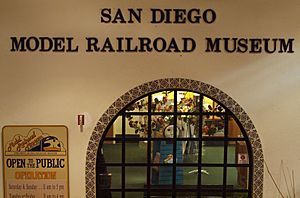San Diego Model Railroad Museum facts for kids
 |
|
| Lua error in Module:Location_map at line 420: attempt to index field 'wikibase' (a nil value). | |
| Established | 1980 |
|---|---|
| Location | Casa de Balboa Balboa Park, San Diego, California |
| Type | Museum and Exhibition Hall |
The San Diego Model Railroad Museum is a special museum in San Diego, California, that shows the history of trains using amazing model railroads. It is located in the famous Balboa Park inside the Casa de Balboa building.
Opened in 1982, this museum is the largest of its kind in North America, covering 27,000 square feet. That's almost half the size of a football field! It is a non-profit organization, which means its main goal is to educate people about railroad history.
Contents
History of the Museum
The story of model trains in Balboa Park began long before the museum opened. Back in 1935, a huge fair called the California Pacific International Exposition was held in the park. A man named Minton Cronkhite, a pioneer in model railroading, was hired to build a giant model railroad for the event.
During the Great Depression, a tough time for the country, companies like the Atchison, Topeka and Santa Fe Railway used these large model train exhibits to get people excited about traveling by train. Cronkhite's amazing display was a major attraction at the 1935 fair. This early exhibit sparked the interest that eventually led to the creation of the museum we see today.
Explore the Main Exhibits
The museum features some of the biggest and most detailed model railroad layouts you'll ever see. The models are built in different sizes, called scales. The most common are HO scale and N scale, but there are also larger O scale models.
Tehachapi Pass (HO Scale)
This huge two-level layout shows the famous railroad line between Bakersfield and Mojave. It is set in the 1950s and features the incredible Tehachapi Loop, a section of track where the railroad circles over itself to climb a steep mountain.
The creators of this model were dedicated to making it look real. They used thousands of photos to build the layout with amazing accuracy. Almost every curve and track switch on the model matches the real-life location.
San Diego & Arizona Eastern RR (HO Scale)
This 4,500-square-foot layout is based on a real railway that ran from downtown San Diego's Union Station all the way to El Centro. The model takes you on a journey through the rocky Carriso Gorge and into the desert.
Pacific Desert Lines (N Scale)
This N scale layout is special because it's based on a railroad that was planned but never actually built. N scale models are very small, which allows for a lot of track in one space. This layout has 33 scale miles of mainline track, which is over 1,000 feet of actual track!
Cabrillo & Southwestern (O Scale)
This 2,700-square-foot layout is the biggest of the three scales. It's a "freelance" model, which means it's not based on a real railroad. Instead, it imagines a fictional route from San Diego to Sacramento.
Toy Train Gallery (O Gauge)
Perfect for kids and families, this gallery features classic toy trains like the ones made by Lionel. The large layout has four different tracks, fun scenery, and lots of moving parts.
Club members operate the trains using modern remote controls. You can also see a collection of rare Lionel and American Flyer trains from the 1920s to the 1950s. Best of all, there's an interactive layout where kids can push a button to make a train run all by themselves!
The People Behind the Trains
The incredible model railroads in the museum were built and are taken care of by four local railroad clubs. The members of these clubs volunteer their time and skills to create these amazing miniature worlds for everyone to enjoy.
The four clubs are:
- San Diego Model Railroad Association
- La Mesa Model Railroad Club
- San Diego Society of N-Scale
- San Diego 3-Railers
Research Library
The museum also has a library filled with books, magazines, and videos about both real and model railroads. It's a great place for visitors who want to learn more. The books are for reference only, so you can read them inside the museum.
See also
 In Spanish: San Diego Model Railroad Museum para niños
In Spanish: San Diego Model Railroad Museum para niños
- List of railway museums







